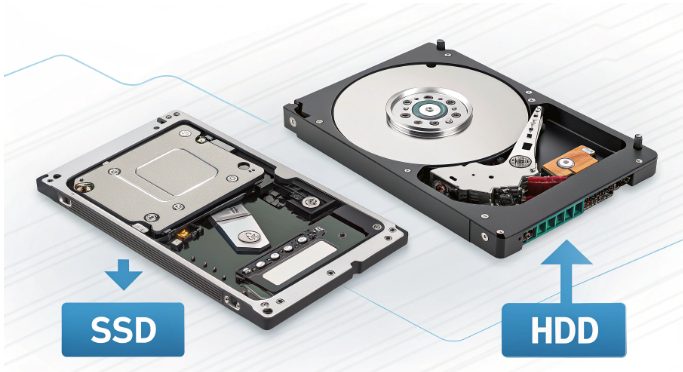Compare SSD and HDD in US Server Hosting

In the complex and ever-evolving realm of US server hosting and enterprise storage solutions, the strategic choice between Solid State Drives (SSDs) and Hard Disk Drives (HDDs) stands as a pivotal decision that profoundly influences system performance, reliability, and operational efficiency. This comprehensive technical analysis delves deep into the fundamental differences, performance characteristics, and specialized use cases of these storage technologies in modern server environments, offering insights for IT professionals and decision-makers seeking to optimize their infrastructure.
Understanding Storage Architecture
HDD Architecture
- Employs sophisticated rotating platters with variable speeds ranging from entry-level to enterprise-class configurations
- Precision-engineered mechanical read/write heads with advanced positioning systems
- Time-tested magnetic storage principle with continued technological refinements
- Optimized track-based data organization with enhanced areal density
SSD Architecture
- Advanced NAND flash memory arrays with multi-layer cell technology
- Solid-state construction eliminating mechanical constraints and vulnerabilities
- High-performance parallel data channels with optimized controller designs
- Enterprise-grade wear-leveling algorithms ensuring prolonged endurance
Performance Metrics Analysis
Enterprise SSDs demonstrate remarkable performance advantages in demanding server environments, showcasing technological superiority in several critical metrics:
- Sequential Read/Write Performance:
- Enterprise SSDs: Exceptional throughput capabilities leveraging advanced controller architectures and optimized NAND configurations
- Enterprise HDDs: Consistent performance suitable for sequential workloads with mechanical precision
- IOPS (Input/Output Operations Per Second):
- Enterprise SSDs: Outstanding random access performance with multi-channel architecture
- Enterprise HDDs: Reliable performance for traditional workloads
- Latency Characteristics:
- Enterprise SSDs: Near-instantaneous response times with minimal variation
- Enterprise HDDs: Predictable latency patterns suitable for specific workload profiles
Reliability and Durability Factors
Contemporary enterprise storage solutions emphasize robust data integrity and exceptional longevity through advanced engineering:
- HDD Reliability Characteristics:
- Impressive Mean Time Between Failures demonstrating mature technology
- Engineering considerations for mechanical component longevity
- Environmental sensitivity requiring specialized deployment considerations
- SSD Reliability Features:
- Extended operational lifespan through sophisticated wear management
- Enhanced reliability through elimination of mechanical components
- Advanced Program/Erase cycle management with enterprise-grade endurance
Cost-Efficiency Analysis
Enterprise storage economic considerations encompass multiple factors beyond initial acquisition:
- HDD Economic Factors:
- Attractive cost per capacity metrics for large-scale deployments
- Established technology with predictable cost structures
- Operational costs influenced by power and cooling requirements
- SSD Economic Considerations:
- Premium positioning reflecting advanced technology implementation
- Higher density capabilities reducing physical infrastructure requirements
- Favorable Total Cost of Ownership through reduced power consumption and cooling needs
Optimal Implementation Scenarios
Strategic storage deployment decisions require careful analysis of workload characteristics and performance requirements:
- HDD-Optimal Scenarios:
- Large-scale archival and cold storage implementations
- Comprehensive backup and disaster recovery systems
- Extensive data warehouse and analytical platforms
- SSD-Optimal Scenarios:
- High-performance database environments requiring consistent low latency
- Dense virtualization platforms with varied I/O patterns
- Mission-critical applications demanding rapid response times
Hybrid Storage Strategies
Contemporary hosting environments frequently implement sophisticated tiered storage architectures:
- Performance-critical data leveraging SSD capabilities
- Frequently accessed data on enterprise-class HDDs
- Archive and reference data on capacity-optimized storage platforms
Future Trends and Considerations
The US server hosting landscape continues its technological evolution with emerging storage innovations:
- Widespread adoption of NVMe protocols revolutionizing storage performance
- Advanced NAND technologies pushing density and performance boundaries
- Innovative computational storage solutions transforming data processing paradigms
Technical Recommendations
For optimal US server hosting performance and reliability, consider these comprehensive technical guidelines:
- Deploy sophisticated monitoring systems for granular performance analysis and predictive maintenance
- Implement robust automated backup strategies with verification protocols
- Design comprehensive redundancy architectures for business-critical systems
- Maintain rigorous firmware management and system maintenance procedures
In the sophisticated landscape of US server hosting and enterprise storage, the strategic selection between SSDs and HDDs requires careful consideration of workload characteristics, performance requirements, and operational constraints. A deep understanding of these technical distinctions enables the creation of optimized storage configurations that align perfectly with specific hosting infrastructure needs and business objectives.

